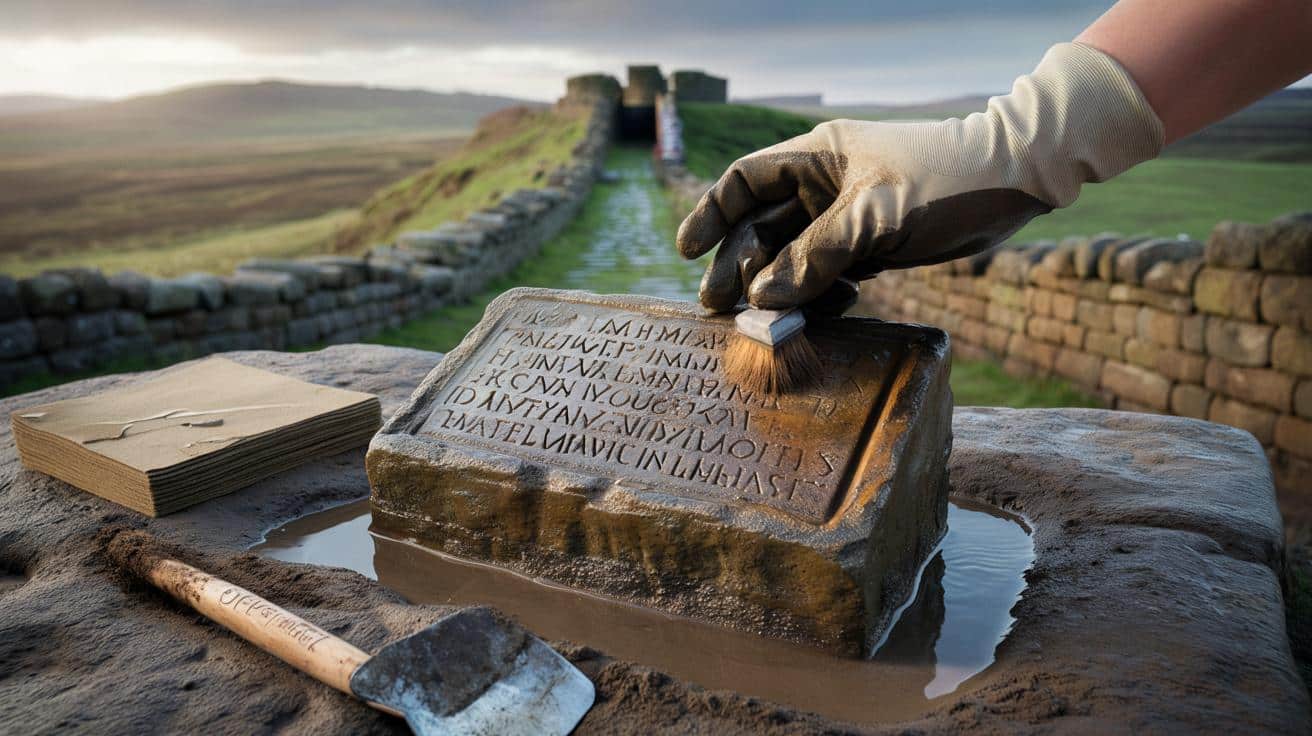Chill in the air, boots in the mud, and a hush that didn’t fit the windy Northumberland afternoon. The trench ran like a shallow scar beside a turf bank, the ground slick with rain and peat. A volunteer’s trowel clinked against something that wasn’t stone in the way other stones are. It was smoother, warmer somehow. We gathered, breath held. The dig lead knelt, slid fingertips along a pale block, and read out the first crisp letters peering through the soil. *I could smell the wet iron of the soil.* On the frontier of an empire, a voice had been waiting under our feet. Then someone brushed off a name.
Pulled from a damp gully beside a fort gateway, the block bears a dedication so sharp it feels freshly carved. Traces of red pigment cling to grooves, hinting the inscription once shouted in colour, not just stone. The air buzzed; even the crows went quiet.
The find is small enough to cradle and heavy enough to demand respect. Its letters—deep, confident—name a unit, a deity, and likely the officer who paid for it. That combination is rare on this frontier. It stitches the Wall to real people, not just to maps and milecastles. In the trench, it felt like a handshake across nineteen centuries.
For context, the Wall runs some 73 miles from coast to coast, a spine of forts, turrets and ditches. Most artefacts here are fragments: potsherds, nails, a sliver of shoe leather on a lucky day. An intact, legible dedication with pigment still clinging to the cut is unusual. At a nearby museum, the staff whispered about “that first line” with the giddiness you’d expect from a cup final.
Why it matters is simple. Named dedications lock a date range to a place and a person, which lets historians tighten the timeline of garrisons and repairs. Pigment, meanwhile, opens new windows: Roman stone wasn’t grey—it blazed. The Wall you picture is wrong, and this block proves it in microscopic dust. If you care about Roman Britain, this isn’t trivia. It’s a recalibration.
What happens after the gasp is a set routine, executed with tender hands. The stone is jacketed in damp pads to slow drying, because pigment flakes when it panics. Photogrammetry records every nick; RTI brings faint letters to life under virtual light. A small sample of the red will go for portable XRF to sniff out the recipe—hematite-rich paint, perhaps tempered with animal glue.
Conservation is a marathon, not a sprint. We’ve all had that moment where you want to scrub the mud off and see the thing shine. Let’s be honest: nobody does that every day. A soft brush, distilled water, and the willpower to stop early are what protect a surface that only looks robust. One overzealous swipe can erase a century of research in a second.
Visitors will soon line up to see it, and that brings its own gentle dance between access and care. The lead archaeologist framed it plainly:
“Objects like this change how we tell the story of the Wall. Not in headlines alone, but in the silences they replace.”
- Stand back from the glass; heat and breath are enemies of fragile pigment.
- Photograph without flash; older dyes are light-shy.
- Read aloud the letters; Latin wakes up when spoken.
- Look for colour ghosts in the cuts, not the flat faces.
If you’re curious how a single artefact can shift the ground beneath a national story, linger on the people tucked into those letters. A centurion’s name hints at origins, pay grade, ambition. The deity named tells you what felt urgent at this latitude—protection, luck, gratitude after a storm. And the stone itself, quarried nearby, speaks to the logistics of an army that breathed masonry like air.
There’s also a quieter note. Finds like this are a coalition: trained archaeologists, local volunteers, the landowner who tolerates muddy bootprints, the museum team who pick up the baton. The Wall is old, but stewardship is young and fragile. One farmer’s gate left properly latched can be as valuable as a grant application.
What’s next? Conservation will stabilise the paint and extract a safe reading of the pigments. Epigraphers will debate a squiggle or two; they always do. Then the block will meet the public, perhaps with its lettering lit at a raking angle so every cut sings. The frontier we thought we knew just grew a new voice. And it’s not whispering.
| Point clé | Détail | Intérêt pour le lecteur |
|---|---|---|
| Named dedication | Unit, deity and donor all appear in crisp Latin | Turns an abstract Wall into real people and places |
| Traces of pigment | Red remains in letter grooves, likely iron-rich paint | Reveals Roman stones were coloured, not drab |
| Frontier context | Found near a fort gateway along the central Wall | Anchors the artefact to a specific moment of garrison life |
FAQ :
- Where along the Wall was it found?On the central Northumberland stretch, close to a fort gateway, in a trench following a drainage gully.
- What exactly is the artefact?A small inscribed sandstone dedication, altar-like in form, with legible Latin and traces of red pigment.
- Why call it “once-in-a-generation”?Because it combines legibility, context and surviving colour—three qualities that rarely arrive together on Hadrian’s frontier.
- When can the public see it?After initial conservation and recording, it’s expected to go on display at a Wall-side museum this season.
- What does it change about the Wall’s story?It refines who was stationed where and when, and shows that carved stones were painted, shifting how we imagine the Roman north.









The pigment angle is huge—Roman stone wasn’t drab. Do we have a provisional reading yet (unit, deity, officer)? And any date bracket from the letterforms? This could definately tighten the garrison timeline.
“Once-in-a-generation” sounds like headline sauce. How many comparably intact dedications with surviving paint have been recorded on the central Wall since 2000? A citaction or dataset link would help before the hype train leaves the station.